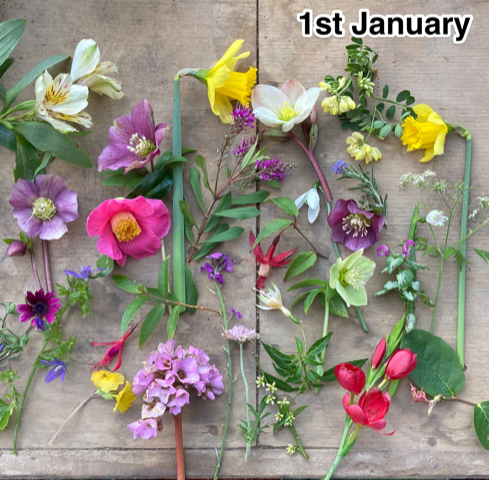January – often a calm month, although sometimes a gloomy month, with days of featureless grey. A little brighter here, a touch of mizzle there.
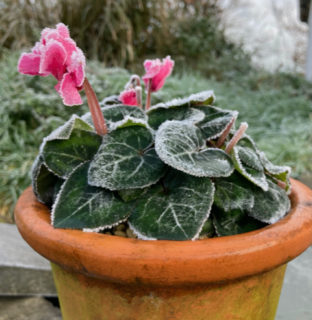 And those bright, sharp days that are beautiful in the light, but the finger-numbing frost never leaves the shadows. Lovely days for working in a sunny greenhouse but not so good in my shady potting shed!
And those bright, sharp days that are beautiful in the light, but the finger-numbing frost never leaves the shadows. Lovely days for working in a sunny greenhouse but not so good in my shady potting shed!
Sometimes it is hard to be inspired to go into the garden in January, but the little gems are there. Snowdrops poking through the soil, in some cases already flowering, such as the irrepressible ‘Mrs Macnamara’ – she usually likes to arrive two weeks before Christmas and then stays for at least a month. ‘Merlin’ is another fairly early variety, but if you can only grow one named variety, try ’S. Arnott’. Quite large, scented and happily increases in number.
There are some brave daffodils to be found, such as ‘Rijnveld’s Early Sensation’. Well named and arriving at Christmas. Bright jewels of Cyclamen coum and winter aconites hiding under trees, fabulous hellebores may already be showing their petticoat flowers, plus other intrepid blooms that shouldn’t normally be out at this time. All are timely food stops for any bees awaking from their slumber. It’s worth taking a stroll around the garden on a nice day to see just how many there are.
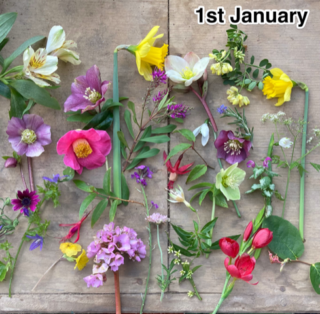 Often a spicy honey fragrance hangs in the air on windless days, I’m yet to find which plant produces this, although it could be Mahonia japonica, reaching more than 4m tall in our garden now as a mature plant.
Often a spicy honey fragrance hangs in the air on windless days, I’m yet to find which plant produces this, although it could be Mahonia japonica, reaching more than 4m tall in our garden now as a mature plant.
Trees and shrubs
Yet there are many jobs to be done in January. This is the month to tend to deciduous trees and shrubs. Starting with apples and pears, if you haven’t pruned them already.
Start with the three Ds – diseased, damaged and dead branches. Cut out any branches showing signs of this, and any branches which cross each other and rub, these will cause damage and an entry point for disease.
Look for signs of canker and try to cut this out, make a cut at least 5cm further down the branch. Remember to disinfect your secateurs or loppers with a wipe of white spirit between cuts if you can. If you saw brown rot over the summer, clear all fallen leaves and any remaining fruit and destroy them, do not compost them.
If your tree needs a more serious renovation, try not to remove more than 25% of the branches. Leave the rest for next year. Create an open goblet shape for your tree which will allow air to circulate and for the sun to reach the fruit.
This is also a good time to prune any deciduous shrubs that may have outgrown their space. Any tree or shrub which is resting now can be hard pruned. Leave evergreens to the summer, when they can recover after a prune and put on a bit of growth before the wet and cold of winter. And never prune stone fruits in the winter, this creates entry points for the silverleaf fungus.
An excellent time to plant bare-rooted trees, hedges, shrubs and roses. Prepare the ground by digging a square hole a fair bit larger than the root ball and mixing in some well rotted compost. A handful of chicken manure pellets never goes amiss and some mycorrhizal fungi to help establish the bridge between the roots and nutrients in the soil.
 A square hole? This is to prevent the roots growing in a circle. When they reach a corner they will grow into the more compact surrounding soil, rather than continuing around the circle in the same shape as their original pot.
A square hole? This is to prevent the roots growing in a circle. When they reach a corner they will grow into the more compact surrounding soil, rather than continuing around the circle in the same shape as their original pot.
Herbaceous borders
In the flower beds, if you have early bulbs such as snowdrops, aconites and species crocus then have a bit of a tidy up of fallen leaves and dead herbaceous plants so you can see the early splashes of joy clearly against the dark soil. Cut away the leaves of hellebores to allow the flowers to shine, and destroy the leaves if they have black spot. Don’t put them on the compost heap.
Don’t be in too much of a rush to tidy up elsewhere. Autumn leaves and the hollow stems of herbaceous plants make excellent places for beneficial insects to hide away from the worst of  winter.
winter.
Vegetables
In the veg garden, if you were thinking of starting a new no-dig bed, then now is a good time. By not digging the soil, you leave the soil structure in place and maintain the health of the soil. This means the vital soil microorganisms are not disturbed and are able to help feed plant roots. The thick mulches applied each year will prevent nutrients leaching from the soil in heavy rain, and will seal in moisture in dry periods which means the bed requires less watering, always something to consider as our weather becomes more varied!
When soil is dug over, more weed seeds are exposed each time, meaning many more flushes of weeds to remove. It can also chop up the roots of perennial weeds such as dandelions and thistles to give you lots of new plants!
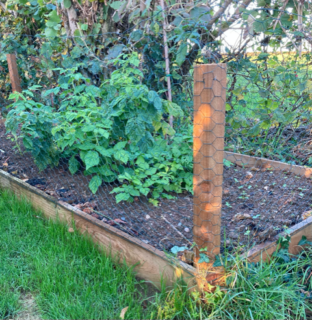 Choose your spot. Knock four wooden pegs into the corners of the area and fix gravel boards to keep the edges of your bed neat. Remove troublesome weeds such as dandelions, thistles, creeping buttercup if you can, using a lawn weed remover or even a bulb planter which will not disturb surrounding soil. Then lay a thick layer – at least 10cm (3”), preferably more – of compost and leave it for nature to do her job. The rain will pummel it and break down clods, and the worms will be more than happy to get involved.
Choose your spot. Knock four wooden pegs into the corners of the area and fix gravel boards to keep the edges of your bed neat. Remove troublesome weeds such as dandelions, thistles, creeping buttercup if you can, using a lawn weed remover or even a bulb planter which will not disturb surrounding soil. Then lay a thick layer – at least 10cm (3”), preferably more – of compost and leave it for nature to do her job. The rain will pummel it and break down clods, and the worms will be more than happy to get involved.
The bed will be ready to plant with veg in the spring. The dark compost will have warmed up faster than soil alone, and it will suppress weeds.
Vegetable seeds that can be planted now, however, are the hardy ones, although they will all appreciate a cosy cloche. Onions, lettuce, peas, beans, radishes. Just a word of warning though if you are not far from the sea, vegetable seedlings do not like salty storms! If you are close enough to have salt air blown in to your garden, either sow indoors or wait until March before sowing. I learnt my lesson the first year I sowed broad beans in winter! They all died within a couple of days of the first storm after they dared to poke their shoots above the soil.
NB
Just a final note on a new challenge us gardeners are facing – fuchsia gall mite. If your fuchsias have looked strange this year, twisted and deformed shoot tips with no flowers, then there is a good chance you’ve caught fuchsia gall mite. It first appeared in the south of England in 2017 but has spread rapidly and I have seen many cases on the Roseland. There is no cure, although it won’t normally kill the plant.
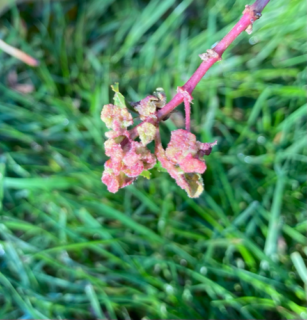 However, if you are not near other gardens which contain fuchsias this could be worth a try – cut down your shrubs as far as possible. When they start to regrow, keep a very close eye on them and cut out any shoots showing symptoms (disinfect your secateurs with white spirit). I fear this is not a long term fix though, and we will be removing many worthy plants before more resistant varieties are found. One consolation is that I have not yet seen it on the silver-pink leaved varieties, even when growing close to the green or gold leaved types. Here is the RHS’s advice on fuchsia gall mite https://www.rhs.org.uk/biodiversity/fuchsia-gall-mite
However, if you are not near other gardens which contain fuchsias this could be worth a try – cut down your shrubs as far as possible. When they start to regrow, keep a very close eye on them and cut out any shoots showing symptoms (disinfect your secateurs with white spirit). I fear this is not a long term fix though, and we will be removing many worthy plants before more resistant varieties are found. One consolation is that I have not yet seen it on the silver-pink leaved varieties, even when growing close to the green or gold leaved types. Here is the RHS’s advice on fuchsia gall mite https://www.rhs.org.uk/biodiversity/fuchsia-gall-mite
Caroline Kenzie
Papaver Garden Design and Tuition (link to go on this text)

